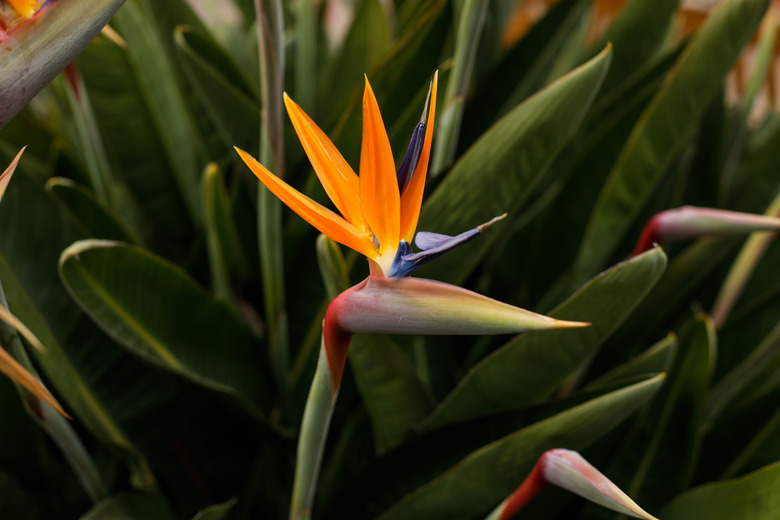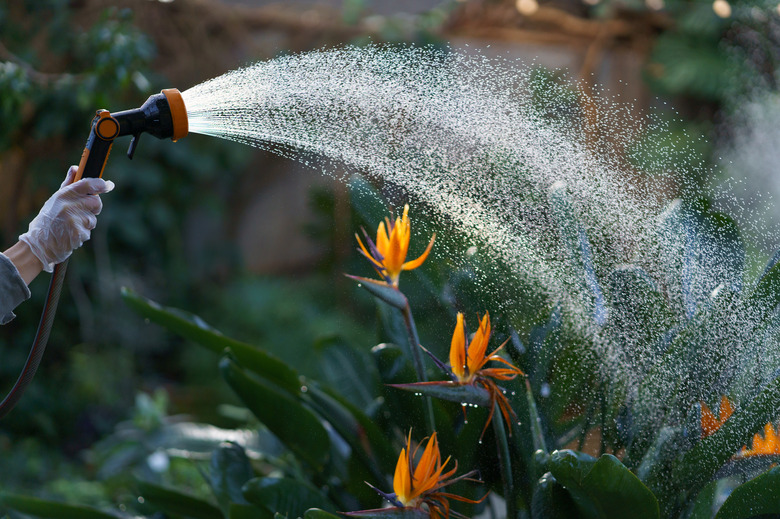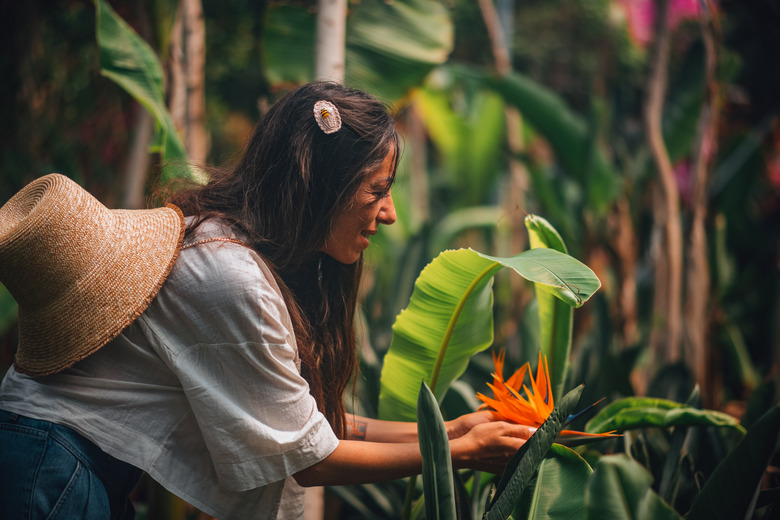How To Cut The Brown Leaves From A Bird Of Paradise Plant
Brown spots on bird of paradise leaves is very a common problem, so pruning is an essential part of this plant's care and upkeep.
The bird of paradise (Strelitzia reginae, zones 10 to 12) and white bird of paradise (Strelitzia nicolai, zones 9b to 11) share a common name and both grow best in warm, frost-free climates. They brighten landscaping with their intricate, colorful flowers and lush tropical foliage.
Ragged or damaged foliage are common in bird of paradise plants, particularly when the plants are grown in hot, dry areas with challenging growing conditions. Pruning to remove the damaged leaves is simple , but must be done often to maintain a tidy appearance in these damage-prone plants.
Why Are the Leaves on My Bird of Paradise Turning Brown and Curling?
There are several causes of brown leaves in bird of paradise plants, including issues with growing conditions or care. Most are minor issues while others signal more serious problems.
Tip
Position bird of paradise houseplants away from air vents and other sources of dry air, which is a major cause of leaves turning brown in these sensitive plants.
Challenging Growing Conditions
**Low humidity and intense direct sunlight can cause bird of paradise leaves to develop crispy, brown edges.**
Low humidity will take a toll on bird of paradise plants whether they growing in an indoor space or outside in a hot, dry climate.
- Using a humidifier will help raise humidity levels around indoor plants.
- Keeping outdoor plants well-watered and misted during periods of hot, windy weather will help keep their foliage green and lush.
Prevent sunburn on indoor plants by moving them away from unshaded south-facing windows if they develop brown leaves on the window-facing side of the plant. Providing light shade at midday will help prevent brown leaves in outdoor birds of paradise.
Watering Issues
Fluoride in the irrigation water and overwatering can lead to problems with bird of paradise plants.
**Fluoride in Tap Water:** The fluoride in tap water is a common cause of bird of paradise leaves turning brown, particularly when they are grown as houseplants. Fluoride toxicity creates brown spots on the leaves and will eventually cause the entire leaf to turn brown.
Watering with distilled water can help prevent this problem. Alternatively, let tap water sit overnight in an open container to allow the fluoride to dissipate before watering.
**Overwatering:** Overwatering bird of paradise plants can lead to root rot. Signs of root rot include wilting, mushy stems and yellow leaves. Maintaining the right moisture balance in the soil will help prevent this serious, potentially fatal problem.
Water only when the soil feels completely dry below the surface. Repot the plant into fresh, dry potting mix and do not water for several days until the roots have time to dry out a bit.
Tip
Be sure to grow bird of paradise plants in a pot with drainage holes or in a garden bed that drains well after rain and irrigation.
Pruning Bird of Paradise Leaves
Bird of paradise plants are not especially disease prone, but it is still a good idea to sanitize your pruning tools before cutting the foliage. Wipe down the cutting blades with household disinfectant or rubbing alcohol to kill off any pathogens.
Tip
Make sure that your pruning blades are sharp and free from nicks so that they produce a clean cut.
Pruning Bird of Paradise Leaves
Remove bird of paradise leaves at any time of year, whenever they present brown discolorations or damage. **Only leaves with greater than 50% brown discoloration should be removed.** The process of pruning away the leaves is straightforward:
- Snip the stem off at ground level, as close to the soil as possible.
- Make the cut at a slight angle, so that water will run off rather than pooling on the cut-edge.
- Wipe off your pruning blade with rubbing alcohol or disinfectant between cuts to prevent the spread of disease.
Another aspect of pruning bird of paradise plants is removing the spent flower stalks, which is called deadheading. Snip off the flower stalks at the base as soon as the blooms fade and lose their color.
Any pruned material should be raked up and thrown away in a green waste bin rather than left on the soil, where it can host insect pests.
**Note:** Wear gloves and long sleeves when pruning bird of paradise plants to protect your skin from the foliage and from any stinging or biting insects that might be hiding among the leaves.
Caring for Bird of Paradise Plants
Pruning is only part of caring for bird of paradise plants. With the right care, not only will your plant bloom better, but it may also develop fewer brown leaves that need pruning.
Watering Needs
Both overwatering and underwatering can damage bird of paradise plants. The best way of ensuring that a bird of paradise has enough water is to fully saturate the root system whenever the soil feels dry below the surface. Let the soil dry out before watering again.
- For potted plants, irrigate the soil until the excess water drains from the bottom of the pot.
- For garden-grown plants, run a hose at the base of the plant on low volume for 10 minutes or until the soil feels very moist 2 inches below the surface.
Tip
Plants growing in full sun need more regular water, while those in shade need less watering because the soil is slow to dry out.
Fertilizer Requirements
A mature bird of paradise needs regular feeding during the growing season. It will not only support blooming, but it can help keep the leaves from turning yellow and developing discolored leaf tips or leaf edges.
- Spread a 1-inch layer of well-rotted manure compost around the base of the plant in spring or use a light application of slow-release granular fertilizer.
- Spread the compost before mulching.
or
- Feed the plants monthly from spring until late summer with a balanced 15-15-15 fertilizer. Use liquid fertilizer or organic granular fertilizer.
When feeding, avoid getting the fertilizer on the plant's foliage, because fertilizer can cause brown spots to form on bird of paradise plant leaves.
Tip
Don't feed bird of paradise plants after late summer, so that any new growth will have time to harden before cold weather sets in.
Mulching Tips
Mulch is another important part of bird of paradise plant care. Mulch helps keep the soil moist when there is a lack of water, which can help prevent stress-related leaf damage. Use a lightweight organic mulch such as pine needles, shredded bark or wood chips.
Tip
Replace the mulch each spring to remove any insect eggs and pests that may have overwintered under the old layer.
- Spread a 2- to 3-inch-thick layer of mulch around the base of the plant. Extend the mulch layer 1 to 2 feet around the plant.
- Leave a 2- to 3-inch-wide gap between the mulch layer and the base of the foliage, which will help prevent stem rot and other issues.
References
- Missouri Botanical Garden: Strelitzia Reginae
- University of Florida IFAS Extension: Strelitzia Nicolai – White Bird of Paradise
- Arizona State University: Strelitzia Nicholii – Giant Bird of Paradise
- University of Central Florida: Pruning – Bird of Paradise
- Logee's Plants: Cultural Information, Strelitzia
- University of Florida IFAS Extension: Bird of Paradise


